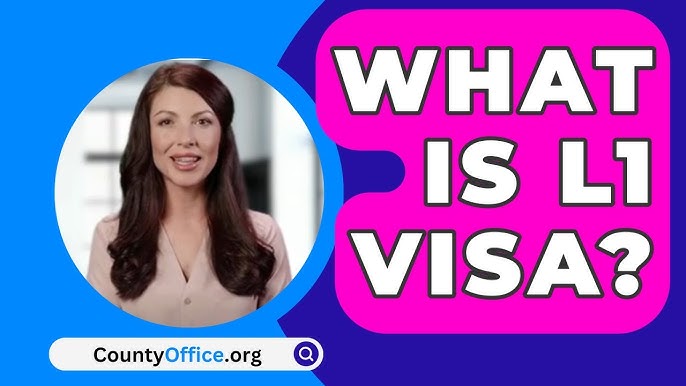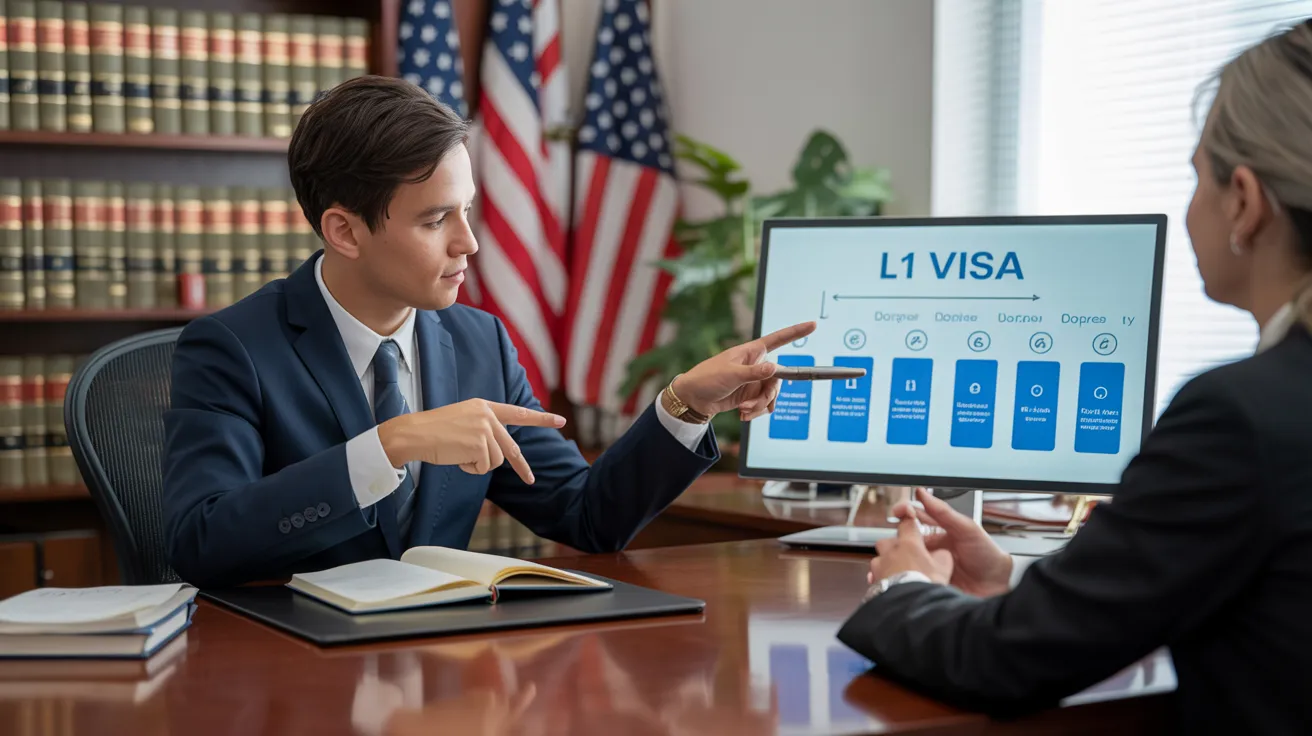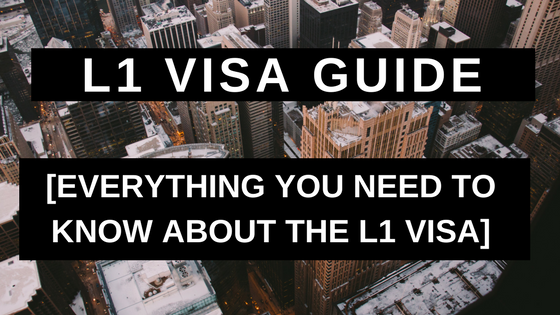Opening Opportunities: A Comprehensive Guide to the L1 Visa Process
The L1 visa process offers an essential pathway for multinational business seeking to move vital employees across borders. Recognizing the nuances of qualification standards, the differences in between L-1A and L-1B visas, and the details of the application procedure can greatly affect an applicant's success. Maneuvering this complex landscape is not without its obstacles, and mindful focus to documents and company sponsorship is crucial. As we check out the essential elements of this process, the techniques for getting over potential obstacles will certainly come to be obvious, exposing just how educated preparation can open up a globe of chances.
Comprehending the L1 Visa
Understanding the L1 visa requires recognizing its value as an important device for international companies looking for to move knowledgeable employees between international offices. This non-immigrant visa group facilitates the activity of execs, supervisors, and specialized knowledge employees to the United States, thus allowing companies to preserve functional continuity and harness international talent successfully. The L1 visa is divided right into two primary classifications: L-1A for supervisors and executives, and L-1B for workers possessing specialized knowledge.The L1 visa offers a critical duty in boosting a company's competitive side in the global industry - L1 Visa. By permitting companies to transfer their crucial employees, businesses can ensure that essential tasks are handled by certified people who are already aware of the firm's society and operational processes. This interior transfer device not only promotes expertise sharing however also promotes innovation and collaboration across borders.Moreover, the L1 visa is commonly preferred for its relatively simple application process compared to other visa classifications, as it permits for twin intent, allowing owners to pursue long-term residency while on a momentary job visa. This function makes the L1 visa specifically appealing for both companies and employees, as it enhances the path for skilled specialists to develop long-term residency in the USA
Eligibility Requirements
Qualification for the L1 visa hinges on numerous vital requirements that assure both the staff member and the employer satisfy certain certifications. This non-immigrant visa is designed for international business to transfer employees from consular services to united state counterparts.Firstly, the employer needs to be a qualifying company, which consists of a moms and dad firm, branch, associate, or subsidiary of a united state business. The company must have been doing company for a minimum of one year both in the U.S. and abroad. This guarantees that the firm has adequate functional stability and a reputable presence.Secondly, the staff member needs to hold a supervisory, exec, or specialized knowledge position. For L1A visas, the candidate must demonstrate managerial or executive certifications, while L1B visas concentrate on specialized knowledge relevant to the organization's items, services, or procedures. Additionally, the staff member should have helped the foreign entity for at the very least one continual year within the last 3 years prior to their application.Lastly, the employee's role in the united state have to align with their previous placement, making certain that their skills and experience are leveraged for the firm's advantage.
Sorts Of L1 Visas
The L1 visa group makes up 2 key types developed to facilitate the transfer of workers within international companies: the L1A visa for managers and execs, and the L1B visa for employees with specialized knowledge. Each kind serves distinctive purposes and has specific eligibility criteria.The L1A visa is tailored for people who hold supervisory or executive settings within a firm. This visa enables top-level employees to move to an U.S. branch, subsidiary, or associate of the very same organization. Candidates for the L1A visa need to show that they have been used in a managerial or executive ability for at the very least one constant year within the previous three years before their application. Additionally, this visa offers a longer duration of keep, at first granted for three years, with the opportunity of expansions for as much as seven years.In contrast, the L1B visa is meant for specialists with specialized understanding related to the company's products, services, or procedures. To qualify, applicants should show that their know-how is important to the company and that they have functioned for at least one constant year within the last 3 years in a role that required this specialized knowledge. The L1B visa is initially granted for 3 years, with expansions available for up to five years.Both visa types are necessary for companies seeking to boost their global operations by leveraging competent workers, thus promoting development and effectiveness within the U.S. market.
Application Process
Steering with the L1 copyright process includes several vital steps that should be carefully followed to guarantee a successful outcome. The procedure starts with the united state company, who need to first establish eligibility by demonstrating a certifying relationship with the international entity and confirming that the worker meets the particular requirements for the L1 visa group being sought.Once qualification is validated, the employer launches the process by filing Form I-129, the Application for a Nonimmigrant Worker, with the United State Citizenship and Migration Solutions (USCIS) This type must be come with by an in-depth summary of the job responsibilities to be performed, the business framework of both the U.S. and international entities, and the employee's credentials. It's essential to validate that all information is exact and total, as noninclusions or inaccuracies can lead to hold-ups or denials.Upon approval of the I-129 application, the following action involves the worker getting the L1 visa at a united state consular office or consulate in their home nation. This phase requires the completion of Form DS-160, the Online Nonimmigrant copyright, and arranging a meeting. Throughout the interview, the applicant needs to offer proof sustaining their qualifications and the employer's petition.After the visa is granted, the worker can get in the United States to operate in the designated function. Overall, cautious preparation and adherence to every action of the application process are essential for a successful L1 visa end result.
Required Documents

Essential Forms Needed
Steering the L1 Visa process needs mindful interest to the crucial forms and paperwork necessary for a successful application. The primary form needed is the Form I-129, Application for a Nonimmigrant Employee, which need to be completed and sent by the united state employer. This kind outlines the details of the work offer and the qualifications of the staff member looking for the L1 Visa.Alongside Kind I-129, the applicant will certainly require to total Form I-539 if going along with household participants are also applying for visas. In addition, the employer needs to provide evidence of the certifying partnership between the U.S. entity and the international entity, often necessitating the submission of company files such as short articles of consolidation or economic statements.Moreover, it is necessary to include the L Classification Supplement to Kind I-129, which specifies the sort of L Visa being asked for-- either L-1A for supervisors and executives or L-1B for staff members with specialized knowledge. Candidates need to guarantee that all types are authorized and dated properly, as incomplete submissions can lead to delays or denials. Appropriately assembling these essential forms lays the foundation for a smoother L1 copyright procedure.

Sustaining Evidence Demands
Supporting documents is essential for a successful L1 copyright, as it validates the claims made in the petition. Candidates must provide a variety of records to show eligibility for the visa, which is classified into 2 key types: evidence of the certifying connection in between the U.S. and international entities and proof of the applicant's qualifications.To develop the partnership, applicants ought to submit documentation such as company organizational charts, monetary statements, and proof of ownership. These records confirm that the international business has a qualifying partnership with the U.S. company, whether as a moms and dad business, subsidiary, branch, or affiliate.For the candidate's credentials, vital files include a comprehensive work letter from the foreign company, detailing the candidate's task title, responsibilities, and period of employment. Additionally, instructional qualifications, such as degrees and diplomas, need to be offered to show the applicant's expertise in the pertinent field.
Employer Sponsorship Papers

Typical Obstacles
Maneuvering the L1 visa procedure offers a number of common challenges that candidates should understand. Secret issues often consist of stringent paperwork requirements, possible delays in handling times, and the requirement for stringent lawful conformity. Understanding these barriers can help candidates better prepare and minimize threats during their copyright trip.
Documentation Demands
The L1 copyright procedure frequently provides substantial challenges related to documents demands. Candidates should supply extensive paperwork to develop eligibility, which can result in complication and possible delays. Trick documents include proof of a qualifying relationship between the U.S. and foreign employer, proof of the candidate's work history, and comprehensive details concerning the task duty in the U.S.One common challenge is gathering adequate proof to demonstrate the nature of the certifying partnership. Firms frequently struggle to present clear business charts or monetary statements that show the link in between the entities. On top of that, ensuring that letters of assistance from companies accurately mirror the candidate's task responsibilities and qualifications is essential, as obscure summaries can lead to denials.Another issue arises from the demand for in-depth task summaries that line up with the L1 visa groups. Applicants should verbalize not only their current function yet likewise their managerial or customized understanding obligations plainly. This requires a complete understanding of both the applicant's position and the governing language utilized in L1 applications.
Handling Time Hold-ups
Experiencing delays in handling times is a typical challenge dealt with by L1 visa applicants, typically leading to stress and unpredictability. A number of elements contribute to these hold-ups, including high application volumes, raised analysis of applications, and administrative backlogs within the united state Citizenship and Migration Solutions (USCIS) Candidates may discover that handling times can vary considerably depending on the solution facility managing their application, as each center has its own workload and performance levels. In addition, the complexity of the candidate's situation, such as the demand for comprehensive documentation or clarification, can better prolong wait times.In some circumstances, problems connected to the candidate's present migration condition or previous visa background may additionally result in extra hold-ups, as USCIS may call for additional testimonial or information. It is essential for candidates to stay positive throughout this period, preserving open communication with their employers and lawful agents to resolve any potential issues promptly.Understanding these handling time challenges can assist L1 visa candidates prepare for possible hold-ups and mitigate the effect on their change and career plans. Perseverance and persistance are crucial merits in maneuvering this complex process.
Lawful Compliance Issues
Lots of L1 visa candidates come across lawful conformity concerns that can complicate their trip towards obtaining the visa. Comprehending and adhering to the certain guidelines established by the U.S. Citizenship and Immigration Services (USCIS) is important. Common obstacles include demonstrating the qualifying connection in between the foreign and united state companies, along with proving that the applicant possesses the requisite customized expertise or supervisory capacity.Additionally, applicants should provide complete documents outlining their job obligations, corporate framework, and monetary viability of the U.S. entity. Inadequate or inaccurate documents can lead to delays or perhaps rejections. Employers must additionally assure that they follow labor laws, including wage and working condition requirements, which can affect visa eligibility.Another common issue entails maintaining compliance with the regards to the visa when granted. Modifications in employment standing, task obligations, or firm structure can require amendments to the visa, which otherwise attended to immediately can cause lawful complications. Consequently, staying educated concerning conformity demands and looking for legal advise when necessary is vital to navigate the complexities of the L1 visa procedure efficiently.
Tips for Success
Success in the L1 copyright process typically hinges on thorough prep work and attention to information. To improve your possibilities of authorization, begin by extensively comprehending the eligibility demands for both the L1A and L1B visa categories. Evaluate whether your placement at the company certifies as managerial, exec, or specialized expertise, as this categorization significantly influences your application.Next, collect substantial documentation that corroborates your cases. This consists of organizational graphes, comprehensive work descriptions, and proof of the business's operational structure. Clear and concise proof of the certifying connection between the U.S. entity and the foreign entity is important. Confirm that all papers are arranged practically and offered in an expert manner, as this reflects your dedication and seriousness regarding the application.Engage the solutions of a skilled migration lawyer who focuses on L1 visas. Their expertise can prove important, directing you with complicated guidelines and assuring that all documents abides by existing laws. Furthermore, get ready for the meeting by exercising response to common concerns and preparing to discuss your function and payments to the business detailed.
Often Asked Inquiries
Can Family Members Members Come With the L1 Visa Holder?
Yes, relative of L1 visa owners, consisting of partners and single youngsters under 21, can go along with the key visa owner. They may additionally get L2 visas, which enable them to reside in the USA.
How Much Time Can I Remain On an L1 Visa?
The L1 visa permits first keeps of approximately 3 years, with the opportunity of expansion. L1A visa holders might stay for an optimum of seven years, while L1B visa owners can continue to be for 5 years.
Can L1 Visa Owners Make An Application For a copyright?
Yes, L1 visa owners can request a permit. L1 Visa Requirements. They may go after long-term residency via employment-based groups, typically requiring sponsorship from their company, offered they meet the needed credentials and paperwork needs
What Happens if My L1 copyright Is Refuted?
If your L1 copyright is rejected, you might receive a L1 Visa law firm notice describing the factors for denial. You can look for to appeal the choice, reapply, or explore alternative visa alternatives based upon your situations.
Are There Any Travel Limitations With an L1 Visa?
An L1 visa generally permits international traveling; however, re-entry to the united state rests upon keeping valid status. Tourists need to guarantee compliance with visa problems to prevent complications upon return
Conclusion
